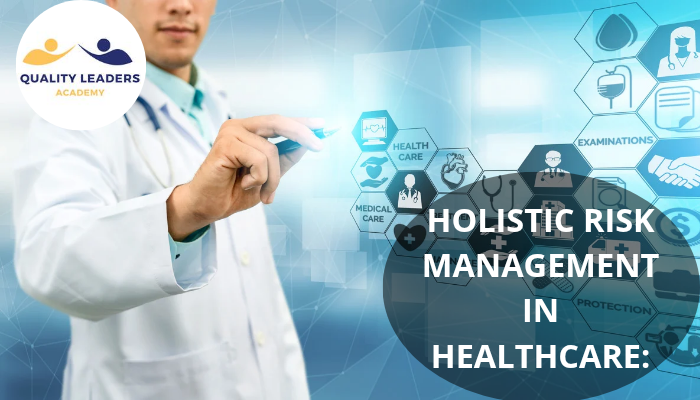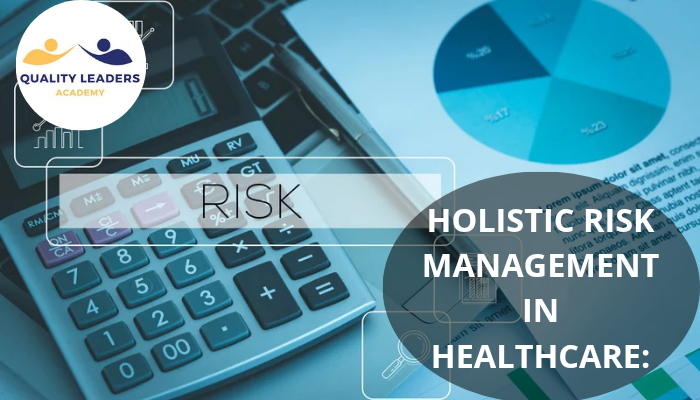Holistic risk management in healthcare is transforming the way hospitals and clinics approach safety, performance, and resilience. As the healthcare landscape grows more complex, blending clinical care, digital systems, legal requirements, and financial pressures, traditional risk management methods often fall short. That's where a holistic approach comes in, helping organizations understand and manage risk from a unified, strategic perspective.
In this article, we’ll explore what holistic risk management in healthcare truly means, why it's essential, how it's implemented, and what benefits it delivers to both patients and providers.
WHAT IS HOLISTIC RISK MANAGEMENT IN HEALTHCARE?

Unlike siloed or reactive methods, holistic risk management in healthcare refers to a comprehensive, organization-wide process of identifying, assessing, and mitigating risks. It considers all dimensions of care delivery, clinical, operational, financial, technological, reputational, and environmental, and examines how these risks interact with one another.
According to research published in ScienceDirect, holistic risk management isn't a separate process but rather an integral part of how an organization operates and evolves. It integrates risk management with strategic goals, making it a core part of decision-making across all organizational levels.
WHY HOLISTIC RISK MANAGEMENT MATTERS IN HEALTHCARE
Healthcare organizations operate in high-pressure environments where a single oversight can lead to serious harm, legal penalties, or system-wide disruptions. Traditional risk frameworks may address issues like patient falls or billing errors in isolation, but they often miss the bigger picture.
Holistic risk management in healthcare recognizes the interconnected nature of today’s risks. For example:
- A cybersecurity breach in an EHR system may not only jeopardize data privacy but also delay patient care, creating clinical risks.
- Understaffing might increase stress levels, leading to burnout, higher turnover, and ultimately, decreased care quality.
A holistic model helps healthcare providers anticipate such ripple effects and design smarter, more resilient systems.
BENEFITS OF HOLISTIC RISK MANAGEMENT IN HEALTHCARE
1. Improved Patient Safety
At its core, holistic risk management prioritizes patient safety. It enables healthcare organizations to look beyond individual incidents and identify systemic weaknesses, such as workflow inefficiencies or communication breakdowns, that can compromise care.
2. Proactive Risk Prevention
Instead of waiting for errors to occur, a holistic model uses predictive tools and cross-departmental data to identify potential issues early. This enables hospitals to address potential issues early, preventing them from developing into more serious risks.
3. Unified Compliance and Governance
Healthcare facilities must comply with numerous regulations (e.g., HIPAA, JCI, CBAHI). A holistic approach integrates these compliance efforts, reducing duplication and improving audit readiness.
4. Better Resource Allocation
By viewing risk across the entire organization, leaders can prioritize high-impact areas and distribute resources more effectively, whether it's investing in staff training, upgrading IT infrastructure, or enhancing clinical protocols.
5. Stronger Organizational Culture
One of the most underrated benefits of holistic risk management in healthcare is its effect on workplace culture. It encourages transparency, collaboration, and shared responsibility across departments, leading to higher employee morale and better patient outcomes.
CORE COMPONENTS OF A HOLISTIC RISK MANAGEMENT SYSTEM
To implement a holistic risk approach successfully, healthcare organizations should integrate the following components:
A. Enterprise Risk Mapping
Start by identifying all potential risks, clinical errors, legal exposure, IT failures, and financial inefficiencies, and map how they might affect each other.
B. Cross-Functional Collaboration
Involve staff from different departments in risk discussions. For instance, a conversation about medication safety should include nurses, pharmacists, IT, and compliance staff.
C. Data-Driven Tools
Use analytics, dashboards, and risk scoring models to monitor patterns, predict incidents, and measure outcomes over time.
D. Leadership Engagement
Executive leaders must champion the process by embedding risk thinking into strategic planning and operational decisions.
E. Continuous Learning and Adaptation
Holistic risk management is an ongoing process. Conduct regular reviews, learn from past events, and adjust protocols as the organization evolves.
REAL-WORLD EXAMPLES: HOLISTIC RISK IN ACTION
Here are some real-world examples of holistic risk in action:
Case 1: Linking Technology to Patient Safety
A hospital experienced delays in patient discharge due to repeated EHR system crashes. Rather than treat it as a standalone IT issue, leadership assembled a cross-functional task force. They uncovered that system downtime increased nurse overtime and created room shortages, impacting both finances and patient satisfaction. Their solution? A system-wide upgrade and staff retraining, guided by holistic principles.
Case 2: Staff Wellbeing as a Risk Indicator
In a medium-sized clinic, rising absenteeism among nurses was initially treated as an HR problem. Looking at the situation more broadly, the leadership team traced the problem back to higher patient complaints, longer queues, and a drop in revenue. They introduced wellness programs and flexible scheduling, improving not just staff satisfaction but also care quality and financial performance.
STEPS TO IMPLEMENT HOLISTIC RISK MANAGEMENT IN HEALTHCARE

If you're looking to adopt this model in your organization, here’s a roadmap to get started:
Assess Your Current Risk Landscape
Review existing processes and identify where risk is being managed in silos.
Engage Stakeholders Across the Board
Include department heads, clinicians, IT, finance, and compliance in early conversations.
Build an Integrated Risk Framework
Develop shared protocols, dashboards, and communication channels for managing and reporting risks.
Invest in Training and Technology
Educate staff about risk interdependencies and equip them with the tools to respond effectively.
Review, Adapt, Repeat
Treat holistic risk management as a living system—review outcomes regularly and update strategies to match new challenges.
Finally, as the healthcare sector continues to face growing demands and uncertainties, from pandemics to cybersecurity threats, holistic risk management in healthcare is no longer optional. It’s a critical strategy for organizations seeking to protect patients, support staff, and remain agile in a rapidly changing world.
By integrating risk awareness into every level of operation, healthcare providers can not only reduce harm but also improve efficiency, compliance, and trust. In the end, it’s about building systems that are not only safer, but smarter, stronger, and more human-centered.
Read also:
CPHRM CERTIFICATION REQUIREMENTS
Resources:
https://www.sciencedirect.com/science/article/abs/pii/S0267364997801744
https://www.linkedin.com/pulse/benefits-holistic-approach-healthcare-risk-management-mark-adams-gsw9f


